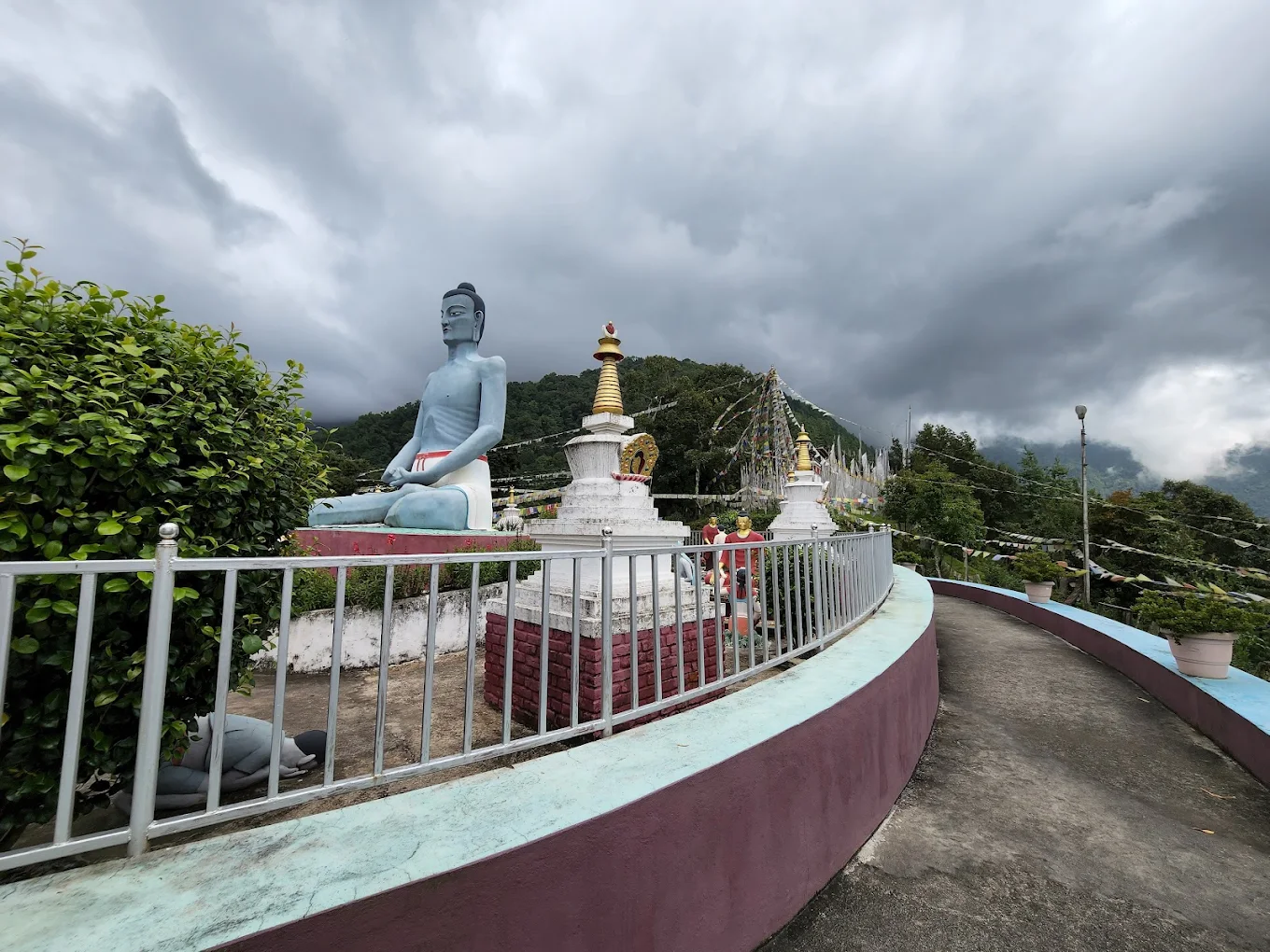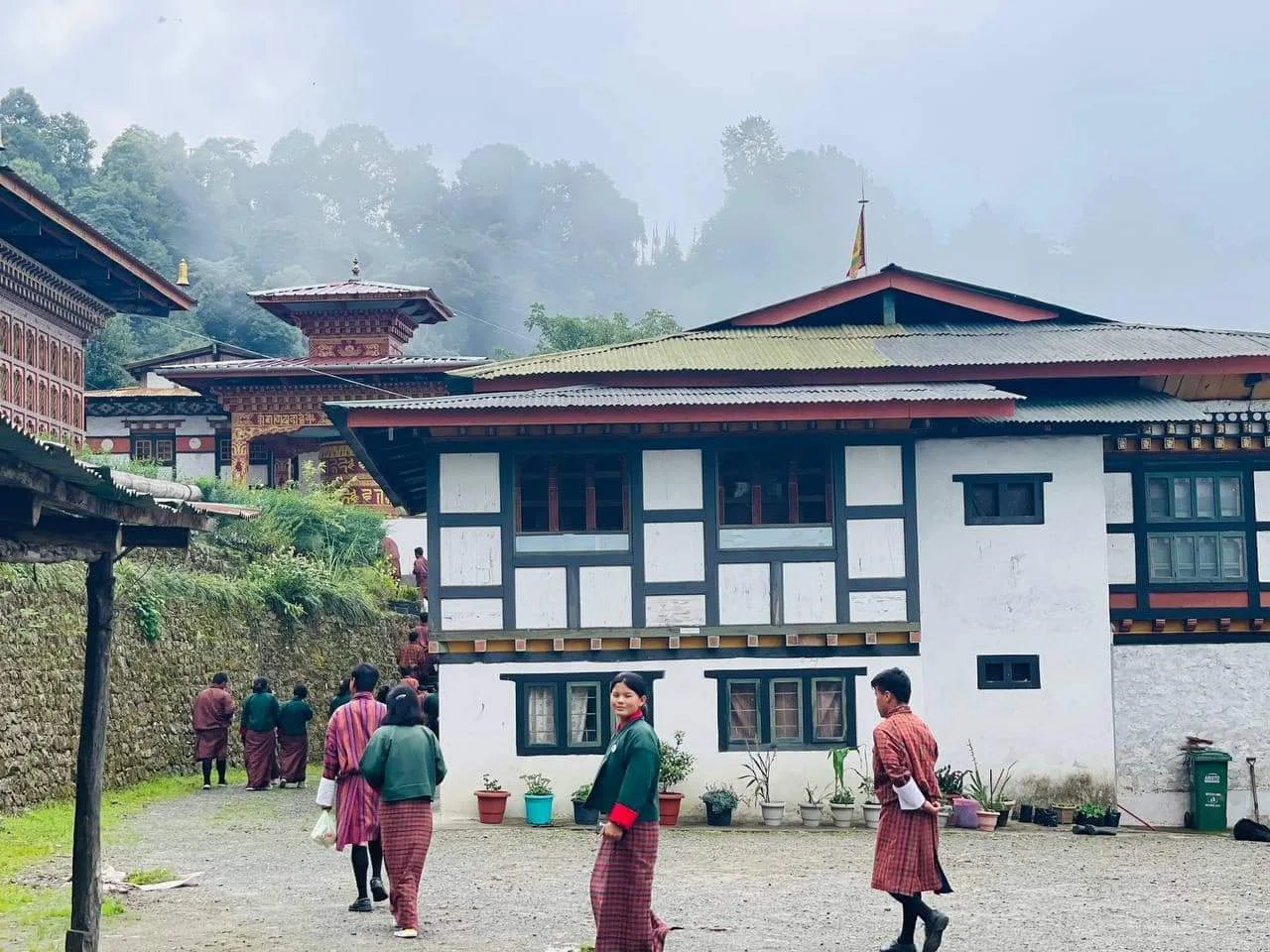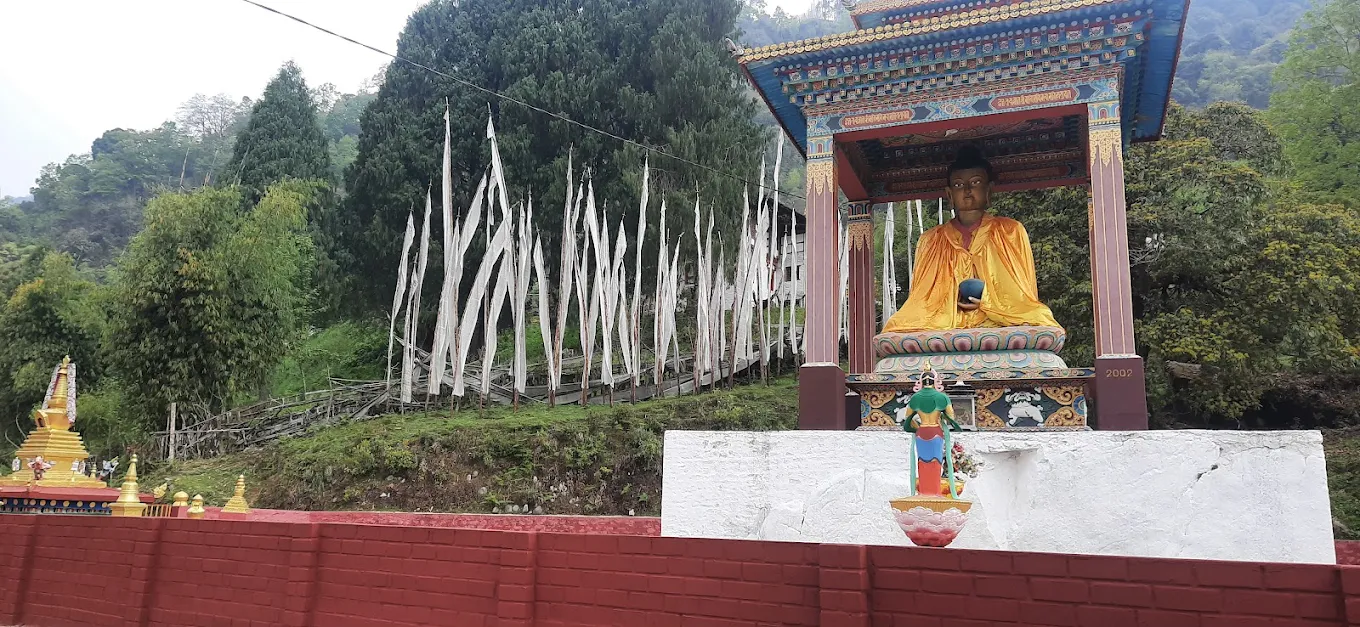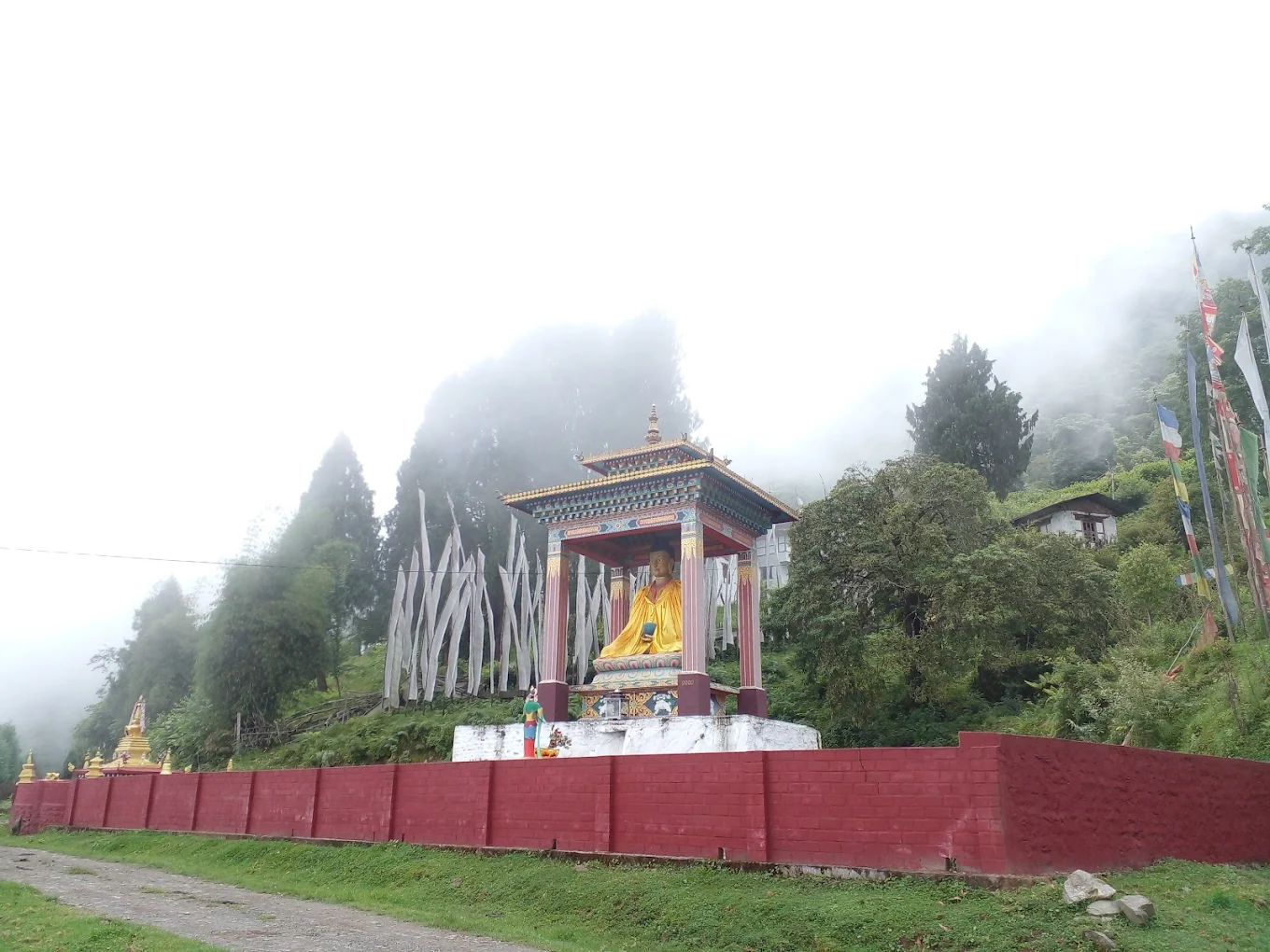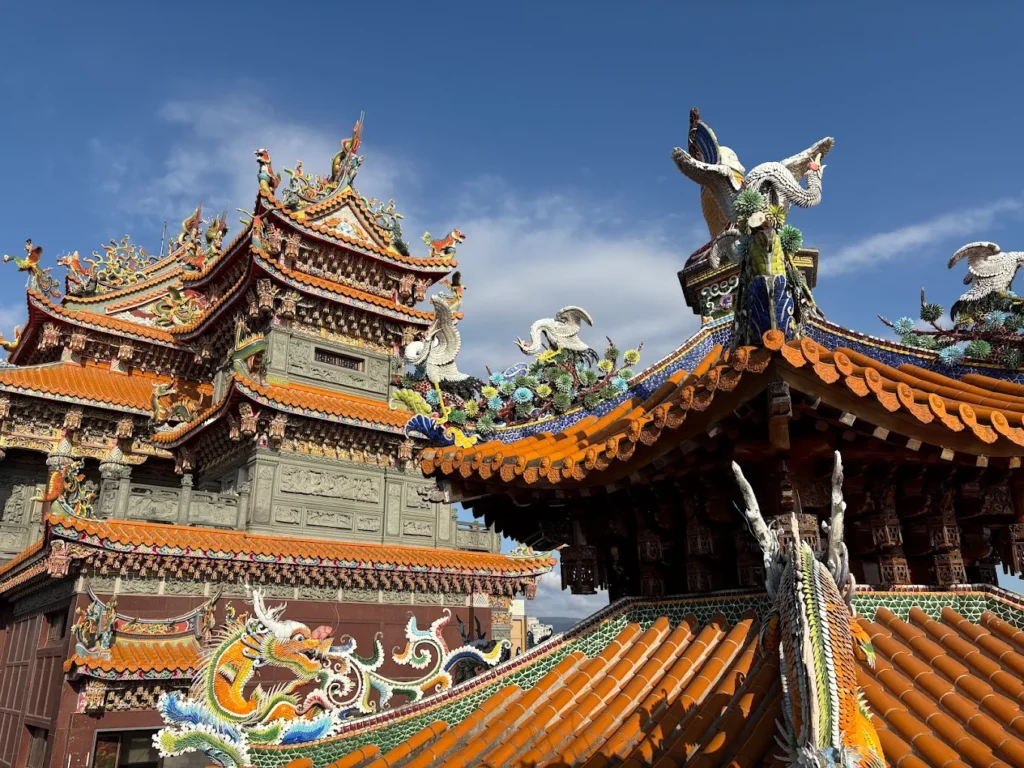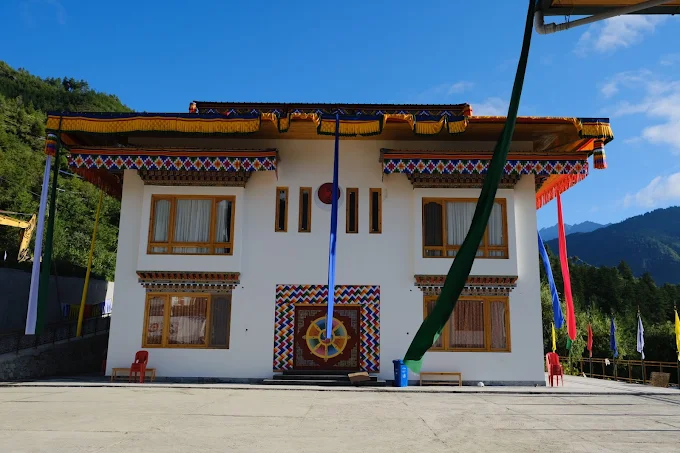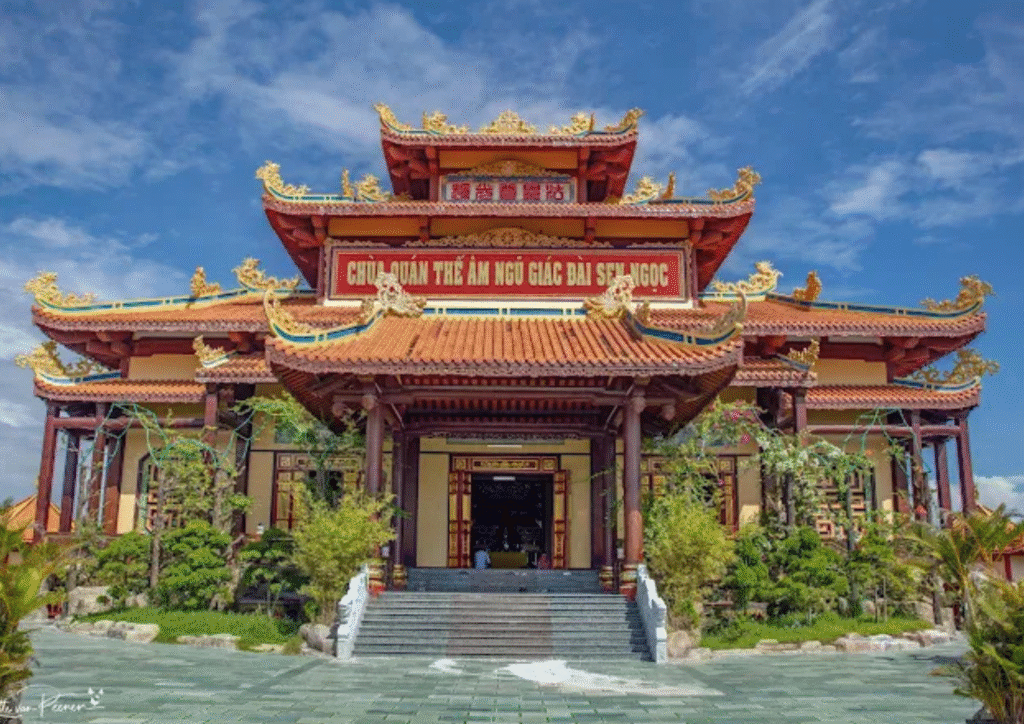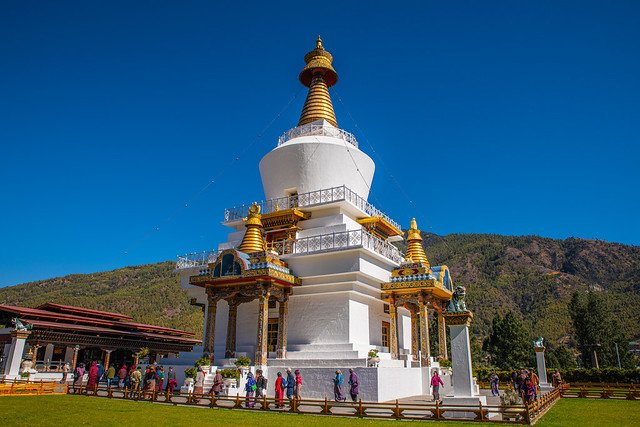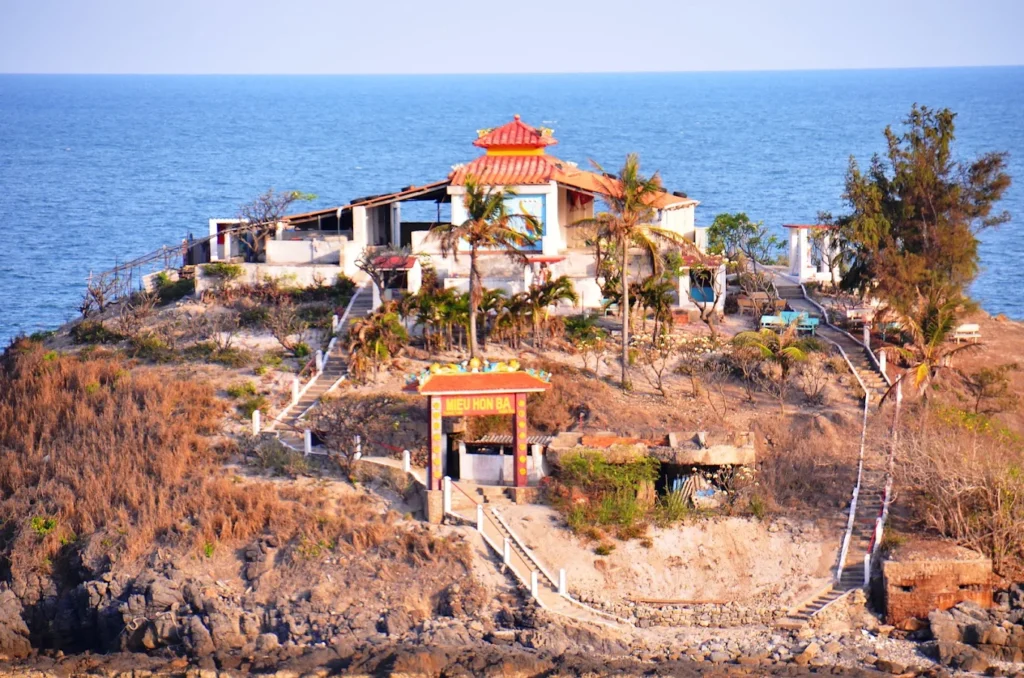Rangshikhar Goenpa: Meditative Haven of Trashigang’s Nyingma Legacy
As dawn crests Trashigang’s rolling hills, Rangshikhar Goenpa stirs above the Gamri River, its whitewashed walls bathed in soft light. Within, a vast Shakyamuni Buddha statue looms, its bronze form joined by Guru Rinpoche (Padmasambhava), as sandalwood incense curls through the prayer hall’s murals. In the courtyard’s Buddha statue park, stone figures trace the Enlightened One’s life, their stillness echoing Togden Jigme Chogyal Rinpoche’s meditative calm. During Tshechu, masked dancers weave through prayer flags, honoring Nyingma’s Dudjom Tersar lineage. Founded by Rangshikhar Rinpoche, born in 1936, this goenpa in Rangshikhar village serves as a meditation center and old-age home, its serenity drawing Sharchop devotees and elders. Perched in Trashigang’s verdant embrace, it blends ritual, compassion, and artistry, inviting seekers to a sanctuary where Bhutan’s spiritual pulse resonates.
Overview and Significance
Rangshikhar Goenpa, nestled above Rangshikhar village in Trashigang, stands as a Nyingma beacon, its meditation halls and old-age home embodying Rangshikhar Rinpoche’s compassionate vision. This monastery weaves devotion, healing, and community, anchoring eastern Bhutan’s spiritual heritage.
Introduction to Rangshikhar Goenpa
Rangshikhar Goenpa crowns a hilltop in Trashigang’s Samkhar Gewog, its white walls and wooden roof a serene emblem of Nyingma Buddhism, Bhutan’s oldest school, rooted in the Dudjom Tersar tradition of revealed treasures. Founded by Togden Jigme Chogyal Rinpoche, known as Rangshikhar Rinpoche, this monastery serves as a meditative haven and old-age home, blending spiritual practice with care for Trashigang’s elders. Its Buddha statue park and grand shrine hall draw Sharchop pilgrims, while Rinpoche’s healing miracles and initiations uplift devotees. Overlooking the Gamri River, it offers a glimpse into Bhutan’s Nyingma soul.
Historical Journey
The goenpa’s story unfolds through Rinpoche’s legacy:
- Founding: Established by Rangshikhar Rinpoche (born 1936), trained under Nyingma masters, to foster meditation and compassion.
- Growth: Expanded to include an old-age home, serving Trashigang’s elderly.
- Rinpoche’s Influence: Known for miracles and healing, Rinpoche drew devotees across Bhutan.
- Continuity: Managed by Rinpoche’s son and daughter-in-law, ensuring its vitality.
Cultural Significance
The goenpa shapes Trashigang’s spiritual landscape:
- Nyingma Center: Transmits Dudjom Tersar teachings, guiding meditation.
- Community Hub: Tshechu unites Rangshikhar’s Sharchop villagers.
- Social Role: Its old-age home reflects Buddhist compassion.
Unique Legacy
Rinpoche’s meditative mastery and the Buddha statue park define its sanctity.
Community and Global Impact
- Local Bonds: Hosts rituals and supports elders, strengthening Rangshikhar.
- Regional Draw: Attracts eastern Bhutanese devotees.
- Cultural Note: Its dual role inspires Bhutanese monastic models.
Historical Anecdotes
- Rinpoche’s healing of a sick villager drew crowds to the goenpa.
- The Buddha park’s creation in the 2000s uplifted local faith.
Social Role
Meditations and elder care knit spiritual and social threads.
Artistic Influence
The park’s statues inspire Trashigang’s sculptors.
The goenpa’s history shapes its form, where murals and statues frame a space of reverence.
Architectural and Spiritual Features
Rangshikhar Goenpa’s whitewashed halls and Karma Ghadri murals blend Nyingma serenity with Bhutanese craft, its Buddha park a meditative anchor. This section unveils its design and sacred spaces.
Iconic Design
The goenpa’s stone walls, topped with a colorful wooden roof, perch above Rangshikhar’s slopes. Its courtyard, fringed by prayer flags, overlooks the Gamri River, with a statue park tracing Buddha’s life.
Key Structures
- Main Prayer Hall (Lhakhang): A spacious chamber with vibrant murals and altars.
- Old-Age Home: A 2000s wing housing Trashigang’s elders.
- Buddha Statue Park: Stone figures depict Buddha’s birth to nirvana.
- Meditation Cells: Small rooms for Rinpoche’s retreats.
Worshipped Statues/Deities
- Shakyamuni Buddha: A large bronze statue symbolizes enlightenment.
- Guru Rinpoche: A bronze icon honors Nyingma’s founder.
Materials and Techniques
Stone walls and timber beams, with mineral-pigment murals, reflect Bhutanese artistry.
Signature Elements
The Buddha statue park and Shakyamuni statue define the goenpa’s heart.
Lesser-Known Features
- Murals of Tersar Lineage: Depict Dudjom masters in the hall.
- Prayer Wheels: Line the courtyard, spun by elders.
Preservation Efforts
Since the 2000s, monks protect murals from Trashigang’s rains.
Environmental Integration
The hilltop perch ties the goenpa to Rangshikhar’s forests, a serene retreat.
Artisan Narratives
Trashigang painters crafted murals, while sculptors shaped the park’s statues.
Symbolic Details
Buddha statues signify life’s stages; lotus motifs evoke purity.
Landscape Integration
The Gamri River view enhances meditative calm, grounding the goenpa.
These spaces cradle the goenpa’s rituals, inviting devotees into Nyingma’s meditative pulse.
Rituals and Practices
Rangshikhar Goenpa’s rituals, rooted in Nyingma’s Dudjom Tersar, blend meditation and ceremony, fostering enlightenment. This section explores its spiritual rhythm.
Daily Sacred Rites
- Sutra Chanting: Monks recite Nyingma texts at dawn.
- Offerings: Butter lamps and incense honor Guru Rinpoche.
- Meditation: Dzogchen sessions focus on innate wisdom.
Unique Practices
Rinpoche’s initiations, held annually, empower devotees with Tersar blessings.
Festival Traditions
- Tshechu: In October, masked dances honor Guru Rinpoche.
- Losar: New Year prayers in February bless elders and villagers.
Visitor Engagement
Guests may join chants or observe initiations, guided by monks.
Spiritual Community Roles
Monks lead rites; elders and villagers support festivals.
Interfaith Connections
Exchanges with Kagyu monks reflect Bhutanese harmony.
Ritual Symbolism
- Butter Lamps: Light signifies wisdom.
- Prayer Flags: Colors balance elements.
Seasonal Variations
Tshechu intensifies in autumn; monsoon retreats deepen meditation.
Monastic/Community Life
Monks meditate; elders tend the park, their work an offering.
These rituals guide visitors to the goenpa’s philosophical core.
Visitor Information
Rangshikhar Goenpa welcomes travelers to Trashigang’s hills, offering practical details to engage with its meditative heart.
Navigating to Rangshikhar Goenpa
Above Rangshikhar village, a 1-hour hike or 13-km uphill drive from Pam village, the goenpa’s white walls stand near the Gamri River, 10 km north of Trashigang town.
Address of Rangshikhar Goenpa
Rangshikhar, Samkhar Gewog, Trashigang District, Bhutan
Visiting Hours and Etiquette
- Hours: Open daily from 7:00 AM to 5:00 PM, extended during Tshechu.
- Etiquette: Dress modestly; remove shoes in the prayer hall; avoid photographing altars.
Transport Options
- Car: A 20-minute drive from Trashigang via Pam, using taxis.
- Bus: Trashigang-Pam buses, then a 1-hour hike.
- Hiking: A 1-hour trail from Rangshikhar village.
Accessibility and Safety
- Accessibility: The courtyard is flat; steps limit hall access.
- Safety: Trashigang is safe, but carry water for the hike.
Amenities and Surroundings
Restrooms and benches in the courtyard; Rangshikhar village offers homestays.
Immersive Tips
Visit in October for Tshechu dances or meditate in the Buddha park.
Nearby Cultural Experiences
- Trashigang Dzong: 10 km away, a 17th-century fortress.
- Rangjung Woesel Choeling Monastery: 15 km away, a Nyingma hub.
Photography Tips
Frame the park at sunrise; respect altar restrictions.
The goenpa’s gates open to its Nyingma philosophy, where faith and compassion unfold.
Cultural and Spiritual Insights
Rangshikhar Goenpa’s essence lies in its Nyingma roots and Trashigang’s spirit, offering insights into Bhutan’s sacred depth.
Religious Philosophy
Nyingma’s Dudjom Tersar teaches enlightenment through Dzogchen, guiding devotees to wisdom.
Environmental Spirituality
The Gamri River valley reflects nature’s sanctity, a Nyingma value.
Artistic Symbolism
Buddha statues embody life’s journey; murals depict Tersar lineage.
Community Resilience
Rinpoche’s old-age home uplifts Barshong’s elders, fostering unity.
Environmental Stewardship
Villagers plant trees, honoring Bhutan’s eco-ethos.
Meditative Practices
Dzogchen sessions cultivate clarity, open to visitors.
Cultural Narratives
Rinpoche’s miracles inspire Tshechu tales, binding Sharchops.
Historical Context
The goenpa ties to Trashigang’s Nyingma revival.
These insights weave a reflection on the goenpa’s enduring presence.
Conclusion
Rangshikhar Goenpa shines as a meditative haven of Trashigang’s Nyingma heritage, its Shakyamuni statue and Buddha park a testament to Rangshikhar Rinpoche’s compassionate vision. Tshechu’s masked dances and Dzogchen meditations pulse with Dudjom Tersar wisdom, weaving serenity into Rangshikhar’s hills. From its old-age home to the Gamri River’s murmur, it fosters devotion amid Trashigang’s forests. As a modern Nyingma landmark, it bridges Bhutan’s lineage with its vibrant community, inviting travelers to pause where prayer flags whisper of timeless enlightenment.
